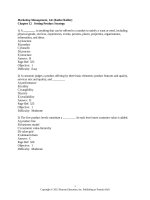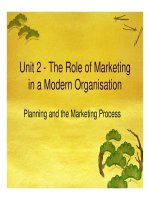Marketing quốc tế Slides BUSM2412 unit 12 s1 08 compatibility mode
Bạn đang xem bản rút gọn của tài liệu. Xem và tải ngay bản đầy đủ của tài liệu tại đây (83.52 KB, 22 trang )
Unit 12 - Marketing
g Planning
g
Marketing Management
Unit 12 Objectives
Understand the relationship between
corporate plans and marketing plans
Understand the process of developing a
marketing plan
Know the components of a marketing
plan
U de s a d implementation
p e e a o issues
ssues
Understand
Inputs
Corporate Plan
Business Portfolio
Capital Investments
and resource allocation
Corporate Culture
p
Structure
Corporate
Marketing Plan
Markets
Products and services
Brand Management
Profit improvement
Strategy
Corporate Plan
Corporate strateg
strategy
based on developing
the organisation’s core
competencies.
Marketing Plan
Marketing strateg
strategy
based on developing:
Market Position
Customer Satisfaction
Focus and Goal
Corporate Plan
Economic Val
Value
e
Added
Shareholder Value
Marketing Plan
Customer
C
stomer Val
Value
e
Creation, Maintenance
and Defence.
Customer Value
The Purpose of a Marketing Plan
A Marketing Plan acts as a roadmap. It’s
purpose is to define and direct marketers
From where they are
To Where they want to be
And
How they are going to get there
How they know when they are there
don t go as planned
What happens when things don’t
Steps in the Planning Process
1. Analyse the corporate objectives
pp p
marketing
g audits
2. Conduct appropriate
3. Complete a SWOT analysis from the audits
p
4. Detail the assumptions
5. Set a limited number of objectives
6 Develop marketing strategies to achieve the
6.
objectives
7. Detail
ea a
an ac
action
o p
plan
a
8. Set out the monitoring and review stages
Step 1: Corporate Mission and
Obj ti
Objectives
The Marketing Plan follows from the
Corporate Objectives
Marketers need to be clear how the corporate
mission and vision might
g impact
p
on any
y
choices of alternatives.
“Is this consistent with, and does it contribute
to fulfilling the corporate mission and vision,
and does it help to achieve the corporate
objectives?”
Step 2: Marketing Audit
The purpose of the Marketing Audit is to
identify and understand as much about the
internal and external environments as
p
possible.
BCG Matrix
GE Matrix
P t ’ 5F
Porter’s
Forces
SWOT Analysis
The Marketing Audit Checklist
The Marketing Audit Checklist
Macro Environment (PESTLE)
Micro Environment
Markets, Customers, Competitors, Channels,
Collaborators, Publics
Customer and market audit
Segments, channels, market forces
Product or value proposition audit
Products, brands, value differentiators
Marketing strategy past performance and
current position
Mission, marketing objectives, strategy, budgets
The Marketing Audit Checklist
Marketing Organisation
Marketing Systems
Marketing Productivity
Marketing
Marketing Function
Step 3: SWOT Analysis
Step 4: Set Objectives
The four-to-six things that the marketing team
are committed to achieving during the period
of the plan.
Can relate to:
Revenue
Market share
Market position
Competitive position
Relationships
Marketing Objectives
Effective marketing objectives need to
be :
SMART
Step 5: Detail Assumptions
Key shareholders can understand the basis on
which the plan is based
Provide a checklist of issues that need to be
monitored
Identify circumstances when the plan needs to
be reviewed
Address the question “what do the plan’s key
stakeholders need to know in order to have
confidence in the plan?”
Step 6: Develop Strategies
Marketing strategies are the statements “how”
the objectives are to be achieved
achieved…
Segmenting the market
Targeting those segments where an exchange
can add value to the customer and value to
the organisation.
Positioning a value proposition through the
marketing
g mix.
The Four Ps
Step 7: Develop an Action Plan
Sets out the specific project plan
elements covering:
What tasks are to be undertaken
Who is responsible
By When
How much it will cost
Resources committed
Step 8: Evaluate Performance
Sets out:
The
Th control
t l measures that
th t will
ill b
be used
d tto
monitor performance
Allows marketers to identify whether goals
are/are not being met
Contingency Plans
Outlines the steps taken in response to any
adverse developments
Marketing Plan Structure
Executive Summary
g Situation
Current Marketing
Assumptions
pp
and issues analysis
y
Opportunities
Objectives
Marketing Strategies
Action Programs
Financials
Controls
Drivers of Success in
Implementation
Ownership of the
marketing plan
Clear and detailed action
plans
Plan Champion /
ownership
hi tteam
Compensation and
rewards linked
M
Management and
d
stakeholder
involvement
Adequate resource
allocation
Skills development
Broad, continuous,
appropriate
i t
communication
Time
Adaptability
Continuous improvement
F db k/
Feedback/measurement
t
Adaptive Roll Out
Reasons for Implementation
Failure
Isolated Planning
Inappropriate trade
trade-offs
offs
Between short and long term objectives
Resistance to change
Lack of detailed implementation plans
Poor or inefficient communications
Marketing department organisation









